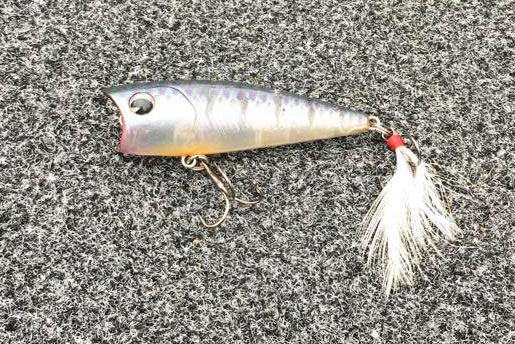June 20, 2021By Justin Brouillard
Editor’s note: If you haven’t read Part 1, read it here.
Ask any angler what their favorite bass bite is, and you’ll most likely hear about topwater. Anglers who finally experience a massive topwater explosion are hooked from the first blow up, and avid anglers crave the exhilarating action. Topwater fishing is known to be most successful during the summer months, but don’t rule out the spring and fall for some of the best topwater action as well.
In this 5-Part Series, Bassmaster Elite Series Pro Paul Mueller takes us through the different types of topwater baits, when and where he employs them, why he chooses one over the others, and his favorite gear for topwater success.
Popper Style Baits
Popper-style baits excel when worked around cover, as their unique cupped bill allows you to keep the bait in the strike zone longer. As a slower moving bait compared to others, Mueller opts for a popper when his area is limited to a smaller strike zone. For example, shady banks casting a shade line, boat docks and grass edges are great places for a popping bait because you are not covering a lot of water, plus you can move the bait slower without sacrificing surface action.
“Cover-oriented baits excel for largemouths because they aren’t as likely to chase bait as much as a smallmouth will. Largemouths tend to stage tighter to cover, which makes a loud bait on the surface intriguing for a nice easy meal. That being said, smallmouths can’t resist a popper either.”
Not only does Mueller look at a popper for smaller strike zones, it is still effective at covering water. Although poppers are typically fished slower than other topwater options, when the spawn ends and the fish are active but not as aggressive, poppers will tempt curious fish.
“When the fish are in that funky time after the spawn, it’s hard to beat a small popper. When I am looking at post-frontal conditions, thunderstorms, pressure-change periods, if the bass are still in range for a topwater, and maybe they won’t commit to other baits, the popper is my first choice. It’s all about their mood and catering to what they want. Fewer people use poppers than walking baits comparatively and I have caught several bass I wouldn’t have otherwise. Add a long pause, be very patient, and hang on.”
Topwater Baits
Mueller sticks to either small finesse profile or larger profile poppers. Matching the hatch and the conditions can be easily accomplished with two popping style baits from IMA Lures and Deps. His go-to finesse popper of choice is the IMA Lures Finesse Popper. Natural colors such as bluegill works the best in clear waters, and for stained or dirty water, consider brighter or more off-the-wall colors. The finesse profile of the 2.6-inch finesse popper really excels in clear water.

“If they won’t eat a walking bait because the water is very clear, they’ll usually eat a popper. Water clarity is the key here and clear lakes without grass seem to be better suited for finesse-popper applications. If you have deeper reservoir with clear water, the fish just like a popper better for some reason and especially right after the spawn is over. Everyone talks about the ‘postspawn funk’ and it’s very hard to beat a small popper during this time.”
For larger popping applications, Mueller reaches for the Deps PulseCod. It is a larger style popper and when the fish are active and keying on bigger baitfish, the bigger bait is key.
“If I am around bigger fish in general or the water is dirty, you want the bigger bait. It helps to call fish from deeper water or cover where fish are relying on the lateral line more versus sight.”
For the larger popper, the colors are more of the same. Let the water clarity dictate the colors. Since most of the larger popper fishing is dirty water, the colors are the opposite. Mueller prefers “stand out” colors and notes that if he is around bluegill and bigger perch, it’s an ideal time to swap to the upsized bait.
Gear
Rod: Dobyns Fury 705CB (Small Baits) Dobyns Fury 703C (Large Baits)
Reel: Lew’s BB1 Pro 8.1:1
Line: 12, 14, or 17-pound Gamma Poly Flex Copolymer
Mueller spools his Lew’s with Gamma Poly Flex line and in super clear conditions, 12-pound does the trick. Depending on the cover, he will increase up to 14 or 17. The finesse popper is best cast on a Dobyns 705CB as the action of the rod allows for increased casting distance.
For the larger popper, a Dobyns 703C is Mueller’s rod of choice. The faster reel helps him keep the slack out of the line when fish jump.
“When dealing with both smallmouths and largemouths, I like the faster reel because the fish will jump and if you can’t keep up with them, they will spit the hooks. Even bigger largemouths will jump and move a lot and it helps to make a long cast and pick up line quickly. After a blow up and a miss, or when bait is busting, I can reel in quickly and get the bait back out there.”



